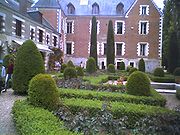
Clos Lucé
Encyclopedia

Amboise
Amboise is a commune in the Indre-et-Loire department in central France. It lies on the banks of the Loire River, east of Tours. Today a small market town, it was once home of the French royal court...
, France
France
The French Republic , The French Republic , The French Republic , (commonly known as France , is a unitary semi-presidential republic in Western Europe with several overseas territories and islands located on other continents and in the Indian, Pacific, and Atlantic oceans. Metropolitan France...
, located 500 metres from the royal Château d'Amboise
Château d'Amboise
The royal Château at Amboise is a château located in Amboise, in the Indre-et-Loire département of the Loire Valley in France.-Origins and royal residence:...
, to which it is connected by an underground passageway. Built by Étienne le Loup in the middle of the fifteenth century, it was acquired in 1490 by Charles VIII of France
Charles VIII of France
Charles VIII, called the Affable, , was King of France from 1483 to his death in 1498. Charles was a member of the House of Valois...
for his wife, Anne de Bretagne. Later, it was used by Francis I
Francis I of France
Francis I was King of France from 1515 until his death. During his reign, huge cultural changes took place in France and he has been called France's original Renaissance monarch...
, as well as his sister Marguerite de Navarre
Marguerite de Navarre
Marguerite de Navarre , also known as Marguerite of Angoulême and Margaret of Navarre, was the queen consort of Henry II of Navarre...
, who began writing her book entitled L'Heptaméron
Heptameron
The Heptameron is a collection of 72 short stories written in French by Marguerite of Navarre, published in 1558. It has the form of a frame narrative and was inspired by The Decameron of Giovanni Boccaccio...
while living there.
In 1516, Francis I invited Leonardo da Vinci
Leonardo da Vinci
Leonardo di ser Piero da Vinci was an Italian Renaissance polymath: painter, sculptor, architect, musician, scientist, mathematician, engineer, inventor, anatomist, geologist, cartographer, botanist and writer whose genius, perhaps more than that of any other figure, epitomized the Renaissance...
to Amboise and provided him with the Clos Lucé, then called Château de Cloux, as a place to stay and work. Leonardo, a famous painter and inventor, arrived with three of his paintings, namely the Mona Lisa
Mona Lisa
Mona Lisa is a portrait by the Italian artist Leonardo da Vinci. It is a painting in oil on a poplar panel, completed circa 1503–1519...
, Sainte Anne
The Virgin and Child with St Anne and St John the Baptist
The Virgin and Child with St Anne and St John the Baptist, sometimes called The Burlington House Cartoon, is a drawing by Leonardo da Vinci, believed to have been executed c.1499-1500. The drawing is in charcoal and black and white chalk, on eight sheets of paper glued together. Because of its...
, and Saint Jean Baptiste
St. John the Baptist (Leonardo)
St. John the Baptist is an oil painting on walnut wood by the artist Leonardo da Vinci. Completed from 1513 to 1516, when the High Renaissance was metamorphosing into Mannerism, it is believed to be his last painting. The original size of the work was 69x57 cm. It is now exhibited at the Musée du...
. Leonardo lived at the Clos Lucé for the last three years of his life, and died there on 2 May 1519.
Today, the Clos Lucé is a museum
Museum
A museum is an institution that cares for a collection of artifacts and other objects of scientific, artistic, cultural, or historical importance and makes them available for public viewing through exhibits that may be permanent or temporary. Most large museums are located in major cities...
that reflects the prestigious history of the region and includes forty models of the various machines designed by Leonardo.

